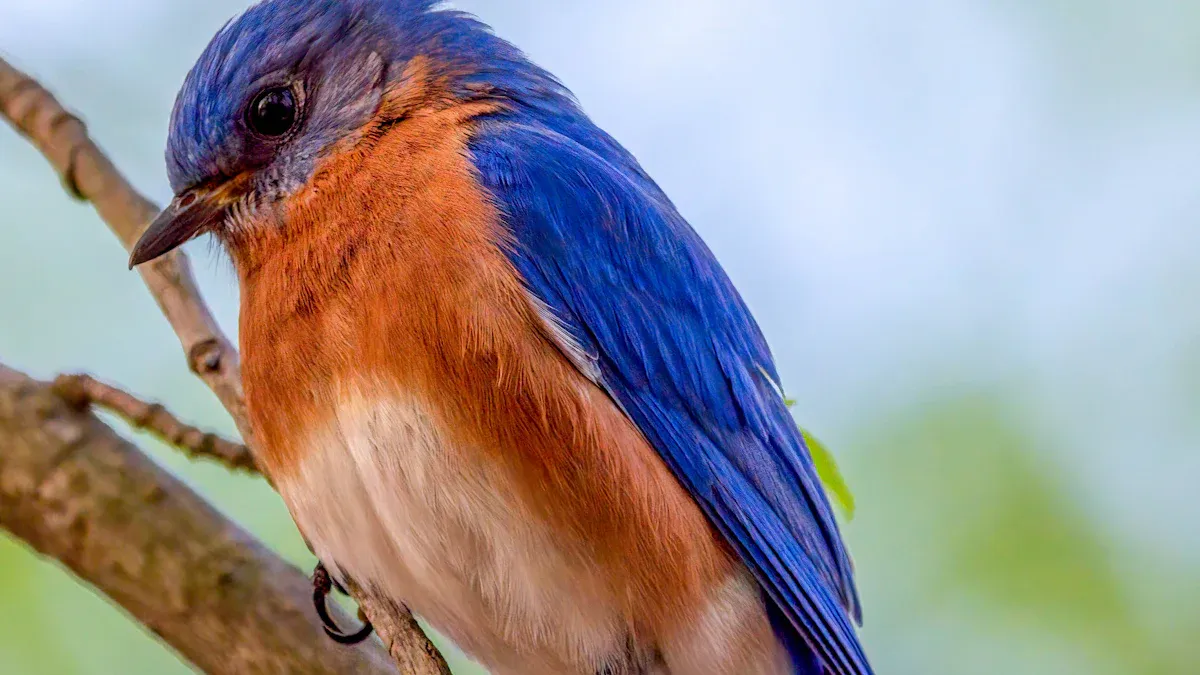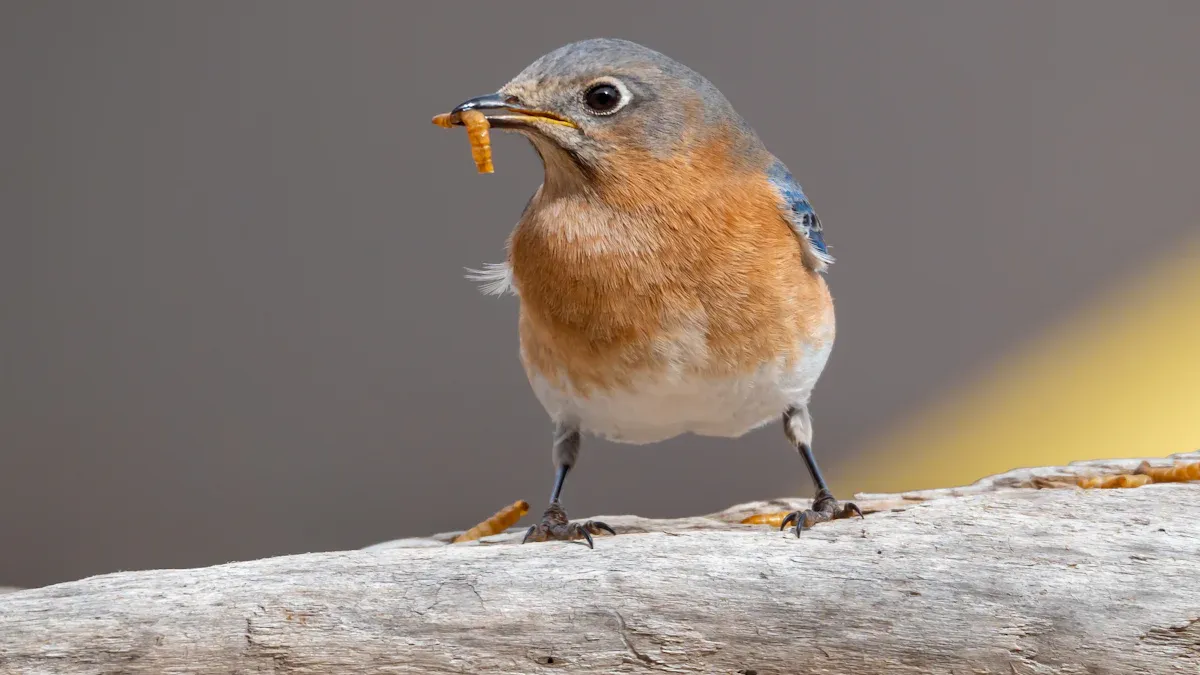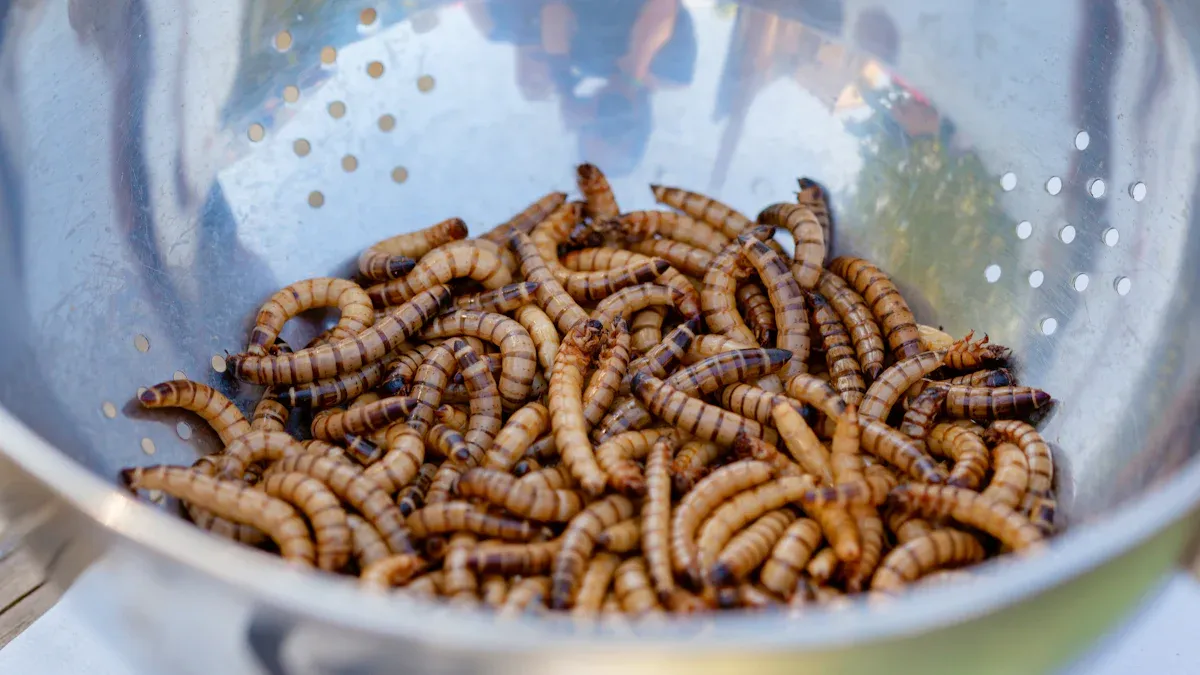
Have you ever wondered how you can make a real difference for bluebirds? Mealworms for bluebirds are more than just a snack—they’re a lifeline. In Central Ohio, trails with mealworms saw no bluebird deaths, while others reported 43. By feeding mealworms, you’re giving these birds a fighting chance to thrive.
キーテイクアウト
- Giving mealworms to bluebirds gives them protein and fats. This helps them stay healthy during nesting and long travels.
- Mealworms are a steady food source for bluebirds. They are important as bluebirds lose homes and deal with changing weather.
- Feeding mealworms helps protect bluebirds and lets you watch them closely.
The Nutritional Value of Mealworms For Bluebirds

Protein for Growth and Energy
Protein is the building block of life, and for bluebirds, it’s absolutely essential. Mealworms are packed with protein, making them a powerhouse food for these birds. Live mealworms contain about 20% protein, while dried ones boast an impressive 53%. This high protein content fuels the energy bluebirds need for daily activities like flying, feeding, and caring for their young. It’s especially critical during the breeding season when adult bluebirds work tirelessly to feed their nestlings. By offering mealworms, you’re giving bluebirds the nutrients they need to grow strong and thrive.
Essential Fats for Health and Survival
Did you know that mealworms also provide essential fats that help bluebirds survive harsh conditions? These fats act as an energy reserve, especially during cold winters or long migrations. In fact, trails where mealworms were provided reported no bluebird deaths, while others saw significant losses. Fats also play a role in keeping bluebirds healthy during spring reproduction, ensuring they have the stamina to raise their young. When you feed mealworms to bluebirds, you’re helping them stay resilient in the face of environmental challenges.
Vitamins and Minerals That Bluebirds Need
Mealworms are more than just a source of protein and fat—they’re also rich in vitamins and minerals that support bluebird health. Here’s a quick look at what they offer:
| Nutrient | メリット |
|---|---|
| Protein | Boosts overall health and development |
| Potassium | Supports muscle and nerve function |
| Selenium | Strengthens the immune system |
| Iron | Helps transport oxygen throughout the body |
| Zinc | Aids in wound healing and immune function |
To enhance calcium intake, you can coat mealworms with calcium carbonate or citrate. This is especially helpful for young bluebirds, as mealworms are naturally low in calcium. By providing these nutrient-packed treats, you’re giving bluebirds the tools they need to stay healthy and strong.
How Mealworms Support Bluebird Health
Enhancing Breeding and Nesting Success
Mealworms play a vital role in helping bluebirds during their breeding season. When you provide mealworms, you make it easier for bluebirds to find food quickly. This is especially important for incubating females, as they can spend less time away from their eggs. Mealworms also act as a lifesaver during food shortages caused by bad weather. They give nestlings the extra nutrition they need to grow strong and healthy. If one parent is missing, mealworms can help the remaining parent manage the demanding task of raising young alone. By offering mealworms, you’re directly supporting bluebird families and increasing their chances of survival.
Providing Energy During Migration
Migration is a tough journey for bluebirds, and they need all the energy they can get. Mealworms are packed with protein, potassium, and other nutrients that fuel their long flights. Did you know a pair of bluebirds can eat up to 100 mealworms a week when feeding their young? This shows just how much energy they require. Mealworms also help young bluebirds survive cold and wet weather during migration. By including mealworms in their diet, you’re giving them the strength to complete their journey and thrive.
Helping Bluebirds Thrive in Winter
Winter can be a challenging time for bluebirds, but mealworms can make all the difference. The fats in mealworms provide a crucial energy reserve that helps bluebirds stay warm and active. Severe weather often reduces the availability of natural food sources, but mealworms can fill that gap. When you feed mealworms to bluebirds in winter, you’re helping them survive harsh conditions and emerge stronger for the next season.
Why Mealworms Are Essential in 2025
Habitat Loss and Declining Natural Food Sources
Bluebirds face a growing challenge in 2025—habitat loss. Urban development and agricultural expansion continue to shrink the spaces where bluebirds once thrived. As their natural habitats disappear, so do the insects they rely on for food. You might notice fewer caterpillars, beetles, and spiders in your area. This makes it harder for bluebirds to find the nutrition they need to survive. By offering mealworms, you can help fill this gap. Mealworms provide a reliable and nutritious food source that bluebirds can count on, even when their natural options are limited.
Climate Change and Its Impact on Insect Populations
Climate change is another major hurdle for bluebirds. Rising temperatures and unpredictable weather patterns disrupt insect populations. Some insects emerge earlier in the year, while others struggle to survive at all. This mismatch in timing leaves bluebirds without enough food during critical periods like breeding and migration. You can step in to help. By feeding mealworms to bluebirds, you ensure they have access to high-quality food, no matter what’s happening in the environment. It’s a small action that makes a big difference.
The Role of Bird Enthusiasts in Supporting Bluebirds
You play a crucial role in bluebird conservation. When you provide mealworms for bluebirds, you’re not just feeding them—you’re giving them a lifeline. Your efforts help bluebirds survive habitat loss, climate change, and food shortages. Plus, feeding bluebirds creates a unique opportunity to observe these beautiful creatures up close. It’s a rewarding experience for you and a lifesaving one for them. Together, we can ensure bluebirds continue to thrive in 2025 and beyond.
Practical Tips for Feeding Mealworms to Bluebirds

Choosing the Right Type of Mealworms
When it comes to feeding bluebirds, not all mealworms are created equal. You’ll find two main options: live and dried mealworms. Each has its own benefits, so choosing the right type depends on your goals. Here’s a quick comparison to help you decide:
| Criteria | Live Mealworms | Dried Mealworms |
|---|---|---|
| Nutritional Value | High | Lower |
| Protein Content | High | Moderate |
| Size | Variable | Smaller |
| Preference | Preferred | Less Preferred |
Live mealworms are packed with nutrients and are a favorite among bluebirds. They’re especially useful during breeding and migration when birds need extra energy. Dried mealworms, on the other hand, are convenient and have a longer shelf life. If you go with dried, consider soaking them in water to make them easier for bluebirds to eat.
Safe and Effective Feeding Practices
Feeding mealworms safely is just as important as choosing the right type. Always use a clean feeder to prevent the spread of disease. Place the feeder in an open area where bluebirds feel safe from predators. Avoid overfeeding, as too many mealworms can lead to nutritional imbalances. A small handful per day is usually enough to support their diet.
Timing and Frequency of Feeding
Timing matters when feeding mealworms to bluebirds. Early morning is the best time since that’s when they’re most active and searching for food. During breeding season, you can offer mealworms daily to help parents feed their young. In winter, providing mealworms a few times a week can make a big difference in their survival. Keep an eye on how much they eat and adjust as needed.
Mealworms for Bluebirds are a game-changer in 2025. They help bluebirds thrive by supporting breeding, migration, and survival during tough seasons. Mealworms also attract bluebirds to nestboxes, assist single parents, and provide food during harsh weather. By feeding them, you’re actively contributing to bluebird conservation and ensuring their future.
🐦 Did you know? Mealworms can reduce the time incubating females spend away from their eggs, boosting nesting success!
よくある質問
What’s the best way to store mealworms?
Keep live mealworms in a ventilated container with wheat bran or oats. Refrigerate them at 40–50°F to slow their growth. 🐛 Dried mealworms can stay in a sealed bag.
Can mealworms attract other birds or animals?
Yes, mealworms might attract other birds like robins or even squirrels. To avoid this, use a bluebird-specific feeder that limits access to larger animals.
How many mealworms should I feed bluebirds daily?
Offer about 10–15 mealworms per bluebird daily. Too many can cause nutritional imbalances. Monitor their consumption and adjust as needed.
🐦 ヒント: Start with small amounts and increase gradually to avoid waste!


